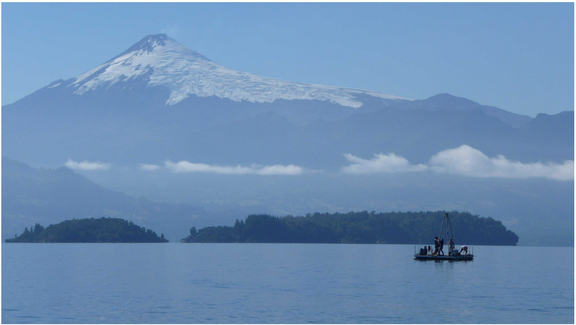QuakeScene Chile – Evaluating megathrust earthquake scenarios in South Central Chile using new strategies in lacustrine paleoseismology
Funded by the Austrian Science Fund (FWF) (July 2022- June 2026; FWF Project Nr. P 34504)
PI: Ass.-Prof. Dr. Jasper Moernaut
Project team at UIBK:
MSc. Ariana Molenaar (PhD student), Dr. Katleen Wils (Post-Doc) and MSc. Valentina Moreno (PhD student)
Project partners:
Ghent University: Prof. Dr. Marc De Batist, Ass.-Prof. Dr. Maarten Van Daele
Univ. Austral de Chile: Prof. Dr. Daniel Melnick, Prof. Dr. Mario Pino, Ass.-Prof. Dr. Ana Abarzua
Univ. de Concepción: Assoc.-Prof. Dr. Gonzalo Montalva, Prof. Dr. Roberto Urrutia
Univ. Libre de Bruxelles: Assoc.-Prof. Dr. Karen Fontijn
Univ. Berlin: Dr. Philipp Kempf
Univ. Newcastle: Assoc.-Prof. Dr. Emma Hocking
Royal Observatory Belgium: Dr. Kris Vanneste
Flanders Marine Institute: Dr. Thomas Vandorpe

The South-Central Chilean subduction zone has produced the largest known earthquake worldwide in 1960 (Mw 9.5). Available historical and sedimentary records suggest important variability in the size, location and recurrence interval of past megathrust ruptures in this area (i.e. Valdivia Segment). Therefore, reliable probabilistic seismic hazard analysis requires a robust reconstruction of spatio-temporal rupture variability based on long sedimentary records distributed along the subduction margin. Numerous suitable lake basins for quantitative lacustrine paleoseismology are present, allowing tracking over several millennia the imprint of strong shaking events. Currently, several shortcomings exist (in Chile and elsewhere) in terms of i) site location, ii) age control, iii) linking sedimentary imprint and ground motion from different sources, and therefore rupture reconstructions are inconclusive.
Overall, the QuakeScene Chile project is constructed around two main seismo‐tectonic aims and will form important advances in our understanding of megathrust earthquake recurrence. It develops and applies new methodological strategies in subduction zone paleoseismology.
AIM1: This project will evaluate megathrust earthquake scenarios over the last 2000 to 5000 yrs in terms of rupture location, extent, and depth based on i) new records in the central part of the Valdivia Segment, ii) direct stratigraphic correlation (relative dating) across basins and types of archives, iii) applying ground motion equations to calibrate turbidite records, and iv) constraining the potential influence of secondary seismic sources. We will address the four main current shortcomings in subduction zone paleoseismology (in Chile) with new strategies.
AIM2: This project will evaluate temporal rupture variability and proposed recurrence models for megathrust earthquakes over the last 5000 yrs by acquisition of strategically‐located long paleo‐shaking records and a statistical analysis on paleo‐earthquake chronologies that will be improved by sensitivity analysis, relative dating methods and targeted absolute dating.
This project will form important advances in our understanding of megathrust earthquake recurrence and this by breaking new methodological ground including i) an unprecedented cross-correlated transect of lacustrine shaking records synchronized by tephra markers, ii) new stratigraphic and chronological strategies to synchronize records and overcome the classic problem of event correlation, iii) the first application of ground motion models on the multi-lake sedimentary imprint of megathrust earthquakes. This pushes the frontiers of subduction zone paleoseismology and can be applied in other subduction zones containing paleoseismic/tsunami archives.
